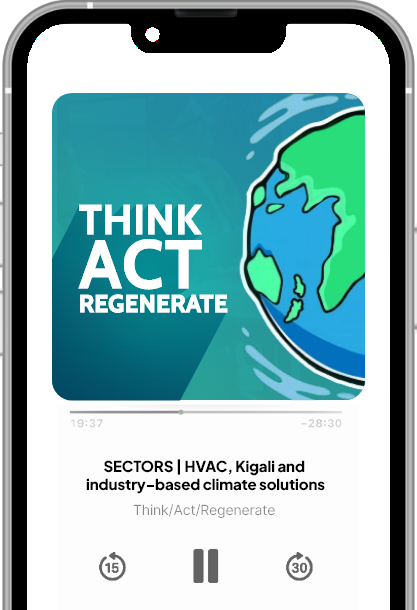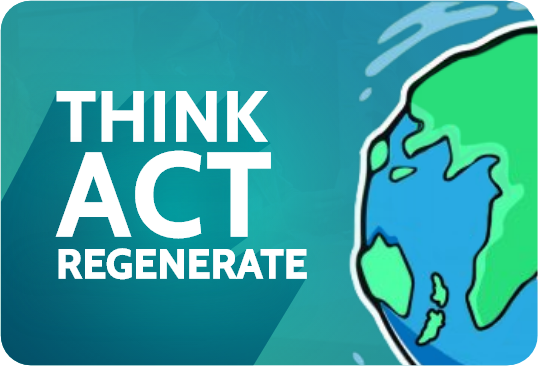
THINK ACT REGENERATE is a podcast by Leigh Baker of ThinkActRegenerate which explores the wealth of regenerative design solutions happening on the ground in Australia and New Zealand, as well as around the world.
Service and value tools for finding business opportunity have been developing for decades – both in mainstream business and sustainability circles.
In Circular Economy circles, they talk about The Service Flip – but there’s a much wider toolkit on offer.
“Regenerative business service and value design is not about finding a better or lower cost solution to the existing problem of an industry. It’s about redefining the problem itself.” Adapted from Blue Ocean Strategy
FULL TEXT:https://thinkactregenerate.com/insight-how-to-uncover-regenerative-service-flip-opportunities/#text
RESOURCE LINKS
FREE Think Act Regenerate INSIGHTS – introductory email series: https://thinkactregenerate.com/insights/
Think Act Regenerate Service Thinking Resources: https://thinkactregenerate.com/product-as-a-service-paas-stories-sources-and-resources/
Circular Design Guide: https://www.circulardesignguide.com/post/service-flip
The Service Economy by Walter Stahel: https://www.globe-eu.org/wp-content/uploads/THE_PERFORMANCE_ECONOMY1.pdf
EXAMPLES
Aspect Legal SME advisory: https://www.aspectlegal.com.au/lawyerline-sme/
Bristol Siddeley “Power by the Hour”: https://www.nexsys.co.uk/knowledge-hub/servitization-jargon-buster/
Lighting services by Signify: https://trellis.net/article/how-philips-became-pioneer-circularity-service/ and https://www.circularx.eu/en/cases/40/signify-light-as-a-service
MUD Jeans as a service: https://mudjeans.com/pages/sustainability-mud-jeans
Rare bird as a service: https://reasonstobecheerful.world/farmers-protect-rare-red-fronted-macaws-bolivia/
Supermarket solar as a service: https://www.smartease.com.au/solar-panels-supermarket-iga/https://www.smartease.com.au/solar-panels-supermarket-iga/
Vogue review of clothing services: https://www.vogue.com/article/clothing-rental-subscription

Service and value tools for finding business opportunity have been developing for decades – both in mainstream business and sustainability circles.
In Circular Economy circles, they talk about The Service Flip – but there’s a much wider toolkit on offer.
“Regenerative business service and value design is not about finding a better or lower cost solution to the existing problem of an industry. It’s about redefining the problem itself.”
In this episode, host Leigh Baker of Think Act Regenerate introduces the Service Flip – and discusses some starting points for uncovering smart regenerative business opportunities.
LINKS
Resources
FREE Think Act Regenerate INSIGHTS – introductory email series: https://thinkactregenerate.com/insights/
Think Act Regenerate Service Thinking Resources: https://thinkactregenerate.com/product-as-a-service-paas-stories-sources-and-resources/
Circular Design Guide: https://www.circulardesignguide.com/post/service-flip
The Service Economy by Walter Stahel: https://www.globe-eu.org/wp-content/uploads/THE_PERFORMANCE_ECONOMY1.pdf
Examples
Aspect Legal SME advisory: https://www.aspectlegal.com.au/lawyerline-sme/
Bristol Siddeley “Power by the Hour”: https://www.nexsys.co.uk/knowledge-hub/servitization-jargon-buster/
Lighting services by Signify: https://trellis.net/article/how-philips-became-pioneer-circularity-service/ and https://www.circularx.eu/en/cases/40/signify-light-as-a-service
MUD Jeans as a service: https://mudjeans.com/pages/sustainability-mud-jeans
Rare bird as a service: https://reasonstobecheerful.world/farmers-protect-rare-red-fronted-macaws-bolivia/
Supermarket solar as a service: https://www.smartease.com.au/solar-panels-supermarket-iga/https://www.smartease.com.au/solar-panels-supermarket-iga/
Vogue review of clothing services: https://www.vogue.com/article/clothing-rental-subscription
CREDITS
Original music composed for the show by Ian Hopkinson of HopkinsonCreative.com – used with permission.
TRANSCRIPT
“Regenerative business service and value design is not about finding a better or lower cost solution to the existing problem of an industry. It’s about redefining the problem itself. “
Adapted from a quote on Blue Ocean Strategy by Chan Kim and Renée Mauborgne
Hello there. I’m Leigh Baker, your host for this episode of the Think Act Regenerate podcast, where we explore the rich smorgasbord of opportunities offered by today’s regenerative solutions.
This podcast episode was recorded and produced on a bush block in Wurundjeri lands on the edge of Naarm, Melbourne, Australia. So it’s possible we’ll get some extra input from the local wildlife.
Episode introduction
In this and coming episodes, I’m continuing to explore some key mindset shifts that I’ve seen evolving in the world of business innovation over the last two decades. I call these shifts insights, because insight is what I’ve developed as I’ve worked to understand and explain them.
Each insight is simply a perspective, a starting point that you can use to explore for high impact business career and community innovation opportunity. Not every insight will apply to every business, every organization, or every career. However, each is an excellent starting place to use to explore for new opportunities.
These insights started life back in 2009 when I distilled my early explorations into regenerative business strategy and practice into a short book called The Deep Green Profit Handbook.
I’ve since turned the book into a short free email series that explains the 10 key design perspectives that I find most useful. Now, I’m summarising those insight emails into audio form as episodes on the Think Act Regenerate podcast.
The first two insights covered a pair of foundational mindset shifts.
Firstly, the shift from sustainability and obligation and compliance and scarcity to innovation and opportunity and creativity.
[00:03:00]
The second shift involves beginning with the end in mind and intentionally designing business models and supply chain systems and production processes that actually regenerate the ecosystems and the communities that they exist within.
After the two foundational insights, there are four supply chain insights and four implementation insights that make up this 10 part series.
You can listen back to past podcast episodes if you want to get caught up, or you can subscribe to the free email series through the link in the show notes.
What is the service flip?
This episode covers the second of the four supply chain insights, the growing business model shift from product thinking to service thinking.
It explores some of the ways that today’s increasing shift towards service and value based approaches is creating business benefits, ecosystem benefits, and community benefits.
The fundamental design principle is that business sells service, always.
To some people, that proposition can sound a bit like it comes from planet Mars. However, it’s an approach that’s been evolving in mainstream business development for more than half a century.
Selling a product as a service goes back at least to the 1960s. When Bristol Siddeley started providing aeroplane operators with “power by the hour” through the servicisation of their Viper aeroplane engines.
They offered a complete engine and accessory replacement service – charged at a set fee per flying hour. Rather than buying the engine, you bought the power it provided. And that allowed aeroplane operators greater forecasting accuracy and relieves them of big capital costs, such as engine stock and accessories.
While product as a service has been around for decades, what’s different today is our ability to do it in a wide range of circumstances.
We have the information technology and communications technology to enable more solutions. We have an increasing understanding of the value that a service model offers.
And we have increasing demands for more sustainability in general. That’s something that service thinking can enable.
So this trend – sometimes called the service flip, often called product as a service – takes business sustainability opportunity to a whole new level.
Product thinking is a pretty deeply embedded human habit. As a species, we’ve been trading in products of various values for millennia probably since the first cave dwellers started swapping spare furs for flint axe heads.
[00:06:00]
Mostly, we buy products that we find valuable or useful, and we take ownership of them. Historically, that has meant that their supplier’s obligation for the thing that they produce largely ends when they deliver it to us.
That had good social controls in a medieval village where you bought tools from your village blacksmith would hear all about product failures fast and personally from local customers.
Today, the products that we buy and their impacts are increasingly remote from us and from our ability to influence how they’re made.
For decades, it’s been increasingly apparent that how the products and services we use every day are made is creating multiple and multiplying environmental harms.
Over recent decades, the world’s innovators and entrepreneurs have been working on solutions. Their solutions challenge all sorts of basic assumptions about how to deliver the result that we want and the value that we’re looking for.
And one of those solutions challenges the whole concept of product ownership – because it can be massively wasteful.
For example, in today’s developed world, we need personal transport to move around with a reasonable level of comfort and convenience, so a lot of us buy a product, a car.
That car will likely spend more than 95 percent of its life in driveways and car parks. In order to give us the value of comfortable, controllable, personal mobility, which is actually the deliverable that most of us want.
Most of us most of the time don’t give a flying fig whether the car is made from steel or carbon fibre, or how its engine functions, or what fuel it uses. We just want to get in it and go places and get stuff done.
Until fairly recently, personal mobility has been predominantly product based. it’s involved owning and operating a vehicle.
The idea of mobility as a service has actually been mainstream for more than a century. We’ve had a few supplementary, if expensive, alternative personal mobility offerings called taxis and car hire. But our approach has largely been product based.
That product based approach has some pretty substantial overheads.
It has the ecosystems, overheads of particulate emissions from internal combustion engines of pollution from spills during bulk oil transport.
[00:09:00]
Plus we have the massive resource usage and subsequent waste of one way production systems that don’t recover or up cycle resources. Systems that are barely 2 percent resource efficient.
On top of that, as consumers, we spend a lot of money on buying, owning, maintaining, and insuring the vehicles that provide our mobility services. Plus parking fees, plus ongoing fuel costs to operate.
The community overheads include the health costs of particulate emission, the land demands of parking, land demands of roads sufficient to make peak traffic volumes.
The community also typically covers the waste handling costs of old vehicles plus parts from tyres to oil filters and oil waste.
And while this example is cars, it’s pretty much the same most product based industries supplying the consumer market, whether it’s electronics or refrigerators or air conditioners.
So it’s not really surprising that smart entrepreneurs and innovators see the expansion of service based business models as an opportunity.
The results of their thinking are increasingly in production in the real world today. Look around, we don’t just have taxis and car hire. We have Uber and eBike rental services, and eScooter services, and urban car share services – including services where you can even share your car when you’re not using it.
There are an increasing number of niches in which product as a service is showing up as offering better value and more sustainability and good regenerative business potential.
So what does this growing trend look like?
There are traditional examples, like formal wear hire, that provides clothing as a service for special occasions. Light and Easy has done meals as a service for decades.
Developments in information technology and communications technology have brought Product as a service to a much broader global audience.
Music as a service
You’ve just got to look at the music industry and how it’s shifted from product to services.
Let’s pull it apart in a bit of detail, because that can be helpful to clarify how to uncover other opportunities.
As consumers, we’ve been recording and playing music since Edison’s time. So whether you grew up in the 1920s or the 1950s or the 1990s, you bought a form of music-playing equipment, and then you bought recordings.
[00:12:00]
Over the decades, your playing device evolved from a hand wound phonograph to an electronic stereophonic sound system. Music’s mobility increased from small wind up phonographs to 70s boom boxes and Walkmen in the 90s.
Along the way, your recordings shifted from 78s made of shellac to 33 1/3 vinyl discs and then to polycarbonate CDs – packaged in increasing layers of paper, cardboard, and plastic.
And all along the way, the players and recordings that you bought were made in largely one way mine/make/use/dump materials models, and delivered across an increasingly globalised manufacturing and distribution network powered by fossil fuel, moved and stored and moved again through warehouses and across oceans and down highways.
As we upgraded from shellac to vinyl to plastic, and from gramophones to Walkmen, our old players and recordings tended to sit in a corner or a closet until they got sent to landfill – or (very occasionally) came back into fashion.
Then the two thousands arrived and the information revolution. And courtesy of that revolution, music started to become a service, with a range of offers, like Napster and then iTunes and Spotify.
That change from product to service meant that music’s ecosystem footprint changed dramatically in a whole lot of ways.
We’ve moved – mostly- from single purpose music playing systems in our homes and started playing music as a service on one or two digital multi function devices – devices that turn electricity into sound waves without shipping extractively manufactured physical products made from fossil oil around the globe.
Music today is by no means a fully fair or perfect industry. And at this point in time, the emissions reductions from making and moving physical products and devices around the planet have been replaced by the electricity emissions of massively increased streaming while we wait for the transition to a fully renewable energy grid.
However, the digital impacts of buying a digital recording transmitted across the internet is likely to be a short term grid transition issue as the circular economy innovations discussed in the previous insight are accelerated globally.
The growing range of services opportunities
We don’t just buy music as a service.
We now buy a whole range of tools as per-user cloud services. We don’t go out and buy a new release of Windows on a CD that we take home and install in our personal computer.
Today, everything from business software like Microsoft Office to recreational services like Minecraft and Fortnite are delivered online. Some of it’s never installed on your computer. You just use it in the cloud, using way fewer physical material products than in the 20th century.
Opportunity hides in constraints
[00:15:00]
To find opportunity, it helps to see the overheads and the constraints of current systems more clearly.
The concept of selling products to make money has largely driven business since the Industrial Revolution, when industry started making everything from crockery and soap to denim and lace – and later cars and air conditioning – and delivering them to an increasingly less exclusive, less wealthy target market.
Product based thinking, like any other form of overused thinking, has its limitations, and the mental models it uses can hide innovation opportunities.
This includes the opportunity to deal with multiple concurrent ecosystem impacts while delivering value to communities.
I’m in the middle of a deep dive blog post on a whole range of product thinking limitations I’ll link to in the future. In this podcast, I’ll stick to a couple of Illustrations.
Product based thinking inherently motivates business towards pushing consumerism.
When your business focuses on your product, it’s easy for you to get stuck in thinking patterns that boil down to “business growth = product sales” – which leads to business growth strategies based on product enhancements.
So you have new product versions with more features and more marketing to create more social pressure for your customers to update. ” Business growth” stops being about selling value and becomes about pushing existing customers to upgrade and conducting an endless search for new customers.
Product based thinking creates barriers to business innovation.
If you’re programmed into the systems and technology of your current products, then your ability to innovate successfully can be constrained.
Kodak and Xerox were really good at inventing, but their ability to turn some of their innovations into new commercial products was limited. Kodak invented the digital camera, but couldn’t get out of the film and chemicals game. Xerox invented the graphic user interface, but it was Microsoft who turned the concept commercial and made Windows a global software enabler.
We might have a different world if car manufacturers had been able to envisage themselves as transport providers, not suppliers to car yards – or if fossil fuel companies had been able to envisage themselves as energy providers instead of extractive miners.
Tools for uncovering opportunity
We have an increasing number of tools that enable us to do service based business innovation.
[00:18:00]
They’ve been around since at least the 60s and it’s been a growing theme in general business innovation.
So regenerative business solutionists today can draw on a wide body of value based business tools like Lean Solutions and Blue Ocean Strategy and Lean Startup, along with more sustainability-based resources such as the Circular Design Guide’s Service Flip.
All of which can help you explore for value outside of default product thinking.
So let’s look at some ways that product can be reconfigured as a service.
Battery as a service
An example of re-configuring a product into a service is a battery based energy storage startup that I encountered earlier this year.
Batteries are made large amounts of expensive physical resources. Many of which are still exploitatively and destructively mined today. Then they’re turned into complex, expensive products that particularly in Australia, need complicated authorisation and installation processes in order to connect them to an energy grid that was never designed for two way, decentralized functionality.
Given their price, energy storage batteries have a relatively limited lifespan and are perceived as having a relatively high failure rate and a certain amount of fire danger. So their take up is, unfortunately, still slow. However, service based thinking can change that equation.
An innovative Melbourne start up called ELIoT Energy which you may have heard me talk about in a previous episode, is out to deliver battery as a service, targeting commercial appliances and vending machines owned by large corporations.
They’ve worked out that they don’t actually need a two way connection to the grid to deliver battery as a service. with a sizeable fleet of right size, one way, but very smart batteries, they can deliver substantial energy usage restructuring. .
They’ll be delivering appliance level batteries as a service to commercial devices like vending machines and coffee machines in hospitality businesses.
That substantial fleet of small batteries – each with a smart controller and connected to a super smart management network – removes barriers to battery uptake and improves energy systems performance.
It’s particularly fascinating because the battery users aren’t the battery owners. because the battery is a service, the hospitality users won’t pay for the batteries, or have any installation because the batteries are standard PowerPoint smart batteries,
[00:21:00]
These smart batteries will self charge on low cost daytime solar energy and draw off that power in expensive evening peaks. And at the same time, they educate consumer customers about the benefits of batteries.
The batteries belong to Elliot. If there’s a problem, Elliot replaces them. If more efficient, cost effective batteries enter the market, then Elliot can just swap them in with no impact on the hospitality venue or the corporate equipment owner.
And with growing circular economy battery solutions, old batteries will increasingly get reused, re manufactured or up cycled into new materials.
Who pays Elliot?
As owners of the batteries and their storage capacity, Elliot has multiple potential customers.
One example is big beverage companies who want to reduce the scope 3 emissions of their promotional refrigerators. Then there’s energy retailers who want to stop wasting the daytime solar going into their grid, and to stop it without major capital expenditure and the lengthy high hassle negotiations of installing two way neighbourhood scale batteries into the grid.
With a big fleet of smaller smart batteries – combined with super smart data analysis and management – Elliott can deliver value and emissions reductions and cleaner power and help energy retailers smooth out the power that they supply.
I’ve given a couple of examples of the limitations of product based thinking, and these problems get worse when they combine with the idiosyncracies of human behaviour -both in individuals and in systems.
A useful way to start to uncover opportunities is to understand the unspoken limitations of product based business models and their unfortunate interactions with the dynamics of human systems behaviour.
Product based ownership thinking interacts poorly with human loss aversion.
Our fundamental neurobiology means that we come with a wide aversion to short term loss, and unnecessary effort, and a deep emotional reluctance to write off sunk costs where we’ve invested a lot of money (even though we know that we’re never going to recover it).
You’d be surprised how many cupboards full of old stereo gear are still sitting in many Baby Boomer homes. (Including mine.)
When we buy a big ticket item, particularly one with limited visibility like an air conditioning unit, we’re going to avoid the cost of replacement and the effort of replacement as long as we can.
So, even when we know about the operational savings to be made on new energy efficiency appliances like heat pump hot water services and air conditioning systems, an awful lot of people are still going to wait until those appliances break down permanently.
[00:24:00]
Inefficiencies and innovation barriers get even worse when ownership gets complex. Human systems are run by human beings. So each person or organisation at each step in the supply chain is mostly inclined to act on their immediate needs and concerns.
And as long as economic value is all about products, that limited scope of control creates further ecosystem overheads.
And that in turn creates a particularly fascinating space to explore for service based opportunities.
Ownership thinking and complex systems
The impact of product ownership multiplies when you have complex commercial situations with expensive products, that deliver services and value to a variety of stakeholders at different levels with a lot of separation between who pays and who benefits.
With split incentives, you can easily end up with fragmented systems whose efficiency is doubly handicapped by perverse and split incentives.
As an example, let’s talk about cooling and heating systems in commercial office buildings. To create a sense of all the different parties involved, I’m going to make up some names. So let’s consider a hypothetical commercial building.
The building is built by Bob’s Company, at the lowest cost that was acceptable for its target market. Bob’s Company could well have chosen the heating and cooling system and its controlling technology on a least cost basis, giving just enough performance capacity to convince an investor that it would give an acceptable result to its tenants.
And as it wasn’t a big, expensive building designed for prestige tenants, Bob’s company saw no need to have a smart building management system installed to monitor the performance of its equipment.
The building that Bob built was bought by ABC Investment, a property investment company. ABC Investment wants to earn income the rents paid by the building’s tenants, so they have limited interest in the efficient operation of the building. Their only interest in cooling is likely to be in terms of the amount of rent that they can charge, because most likely, their tenants are going to pay the energy bills.
The building that Bob’s Company built, now owned by ABC Investment, is managed and maintained by John and Betty Facilities Management, because most investors aren’t interested in fixing plumbing or maintaining air conditioning equipment.
John and Betty Facilities Management get paid for running the building and doing maintenance. But John and Betty don’t pay the energy bills, so they have a limited interest in energy efficiency, like A, B, C. Investments.
[00:27:00]
John and Betty get paid for maintenance of existing plant and equipment. They don’t pay for equipment upgrades, but their work gets disrupted and their training costs increase when new gear gets installed.
John and Betty Facilities Management don’t have a smart building management system that monitors their infrastructure and equipment for performance discrepancies before they cause breakdown. So apart from contracted scheduled maintenance, they can only deal with breakdowns after they happen. Their staff are largely invisible and their wages often tend to the low end.
The offices and the building that Bob built that’s now owned by ABC Investment and managed by John and Betty Facilities Management are leased to tenant businesses. Let’s call them Mary’s Real Estate, Andrew’s Accounting, and Freda’s Financial Planning. These tenant companies pay the energy bills. They experience the comfort or the discomfort of the heating and cooling system.
However, they have no say over the actual heating and cooling machinery beyond fiddling with the thermostat settings. All they can do is report faults to the John and Betty Facilities Management Company and, over time, Make complaints to the owner ABC Investment.
So what happens? Time goes on and the building and its equipment ages. John and Betty Facilities Management do maintenance repair on a least cost basis that favours patches over thorough overhauls and full upgrades.
ABC Property Investment wants the maximum ROI on their building, so upgrading the building’s cooling system to increase its energy efficiency (like other plant and equipment upgrades) is a business cost and a capital expenditure with little direct business benefit to them.
So, should an environmentally responsible tenant want to increase the building efficiency, it’s going to be difficult. Because who’s going to pay for the upgrade, and who’s going to benefit from the upgrade, and who’s going to be disrupted by the upgrade are all different parties.
What we have is a multi factor problem of split incentives where the costs go to one party, the benefits go to another party, and everybody feels the pain of the process.
The result? There’s a good chance that the existing system will likely be run until it breaks at less than optimal efficiency with increased ecosystem impact and more tenant cost.
And when major equipment does break, the chances are fair to medium that it could well be replaced with another similar least disruption least cost unit.
[00:30:00]
So how much does this matter in the scheme of things? 20 percent of all energy generated globally is used by cooling systems, including air conditioning systems and commercial refrigeration.
Maximising the operational efficiency of heating and cooling systems and finding ways to reduce their peak energy demand has huge savings potential. It has benefits for the building tenants, it has benefits for network energy providers who have to meet peak demand, and for ecosystems that get less fossil fuel pollution.
It could also make the building more attractive to future tenants. It could make the building easier to maintain. However, at least while loss-averse humans operate in a product-based business model, the barriers to efficiency and sustainability are big.
But it’s not an unsolvable problem if you switch to service thinking. The economics change substantially when you switch to building management as a service.
So let’s say that ABC Investments decides to contract for smart building management as a service and chooses – let’s call them Bluestar Services – to operate their buildings and deliver comfort and efficiency.
Because they’re buying building management as a service, they hand over both the management AND the building infrastructure to Bluestar Services. Bluestar moves in, rationalises the infrastructure, installs wireless sensors everywhere so they can measure the actual real time performance of the building.
Performance information and warnings of looming problems are now easily available through Bluestar’s Smart Building Management System.
Bluestar take on responsibility the results delivered by the equipment in the building and they have the rights to upgrade the equipment in the building. They aren’t contracted to ” do specified maintenance”.
They’re contracted to provide building performance to agreed levels as measured by the monitoring system. How they meet those targets is up to them, what they replace and when they replace it is up to them as long as they meet the agreed performance criteria.
No one has to do a CAPEX to ABC Investments to convince them to purchase a new air conditioning unit.
If there’s an ROI of even three to five years, then it’s worth it to Blue Star Services to do the upgrade. And if they can improve performance by simply implementing a refrigeration coil cleaning schedule, they do it.
If they can improve the efficiency , of a big water gulping evaporative cooling system by adding an aftermarket vortex based water efficiency module, they do it. If they want to replace a quite new but seriously inefficient chiller unit to save money, they do it.
[00:33:00]
That’s the power of Product as a Service. Designed well, it can change the rules of the game, remove blockages and open up new competitive spaces – blue ocean spaces that are rich in opportunities.
The service flip can be a whole lot of fun. When we take the focus of business off products and expertise and features and shift it to value and results and benefits. Using smarter design and smarter management.
More examples of the service flip
That service flip is spreading in all sorts of ways.
It’s showing up in industries from legal services to fashion to transport and offers multiple benefits that are not limited sustainability”.
Here are some service flip examples, not all of them about sustainability.
There’s a small Australian legal company offering a more affordable model of legal services They’ve reinvented retainer based service business models based on value rather than on billable hours. They’re using technology to offer SMEs more accessible, useful business advice for less money.
Product as a service is happening in consumer fashion, both at the higher end range garments.
In June 2023, when Vogue compared clothing rental subscription services, they found eight different offerings worth evaluating. And that’s at the high end.
But there are also service based offerings outside the luxury market.
Circular Economy innovators MUD Jeans. offer organic jeans for rent by the month. After renting their jeans for 12 months, you get to either swap them for another pair and lease that pair for a year or keep them with the ability to send them back for recycling at end of life.
Their jeans are made using environmentally friendly production processes and when you send them back They’re either resold or recycled.
Here’s a Creative Environmental Protection example: It is effectively Rare Bird as a Service.
In Bolivia, farmers used to capture red fronted macaw chicks and sell them as a product to the pet trade. So much so that the birds were critically endangered. sometimes they also used to kill the birds because they thought they damaged crops. Clearing more land for farming also destroyed bird habitat.
Then a Bolivian bird conservancy agency stepped in with a service model based on the idea that there was considerably more value enabling tourists to see macaws in their native habitat than selling chicks.
[00:36:00]
The conservancy agency partnered with the locals to build an eco-lodge where up to 14 tourists could stay and experience the birds in their natural forest habitat. That lodge delivers $25,000 per year to the local community, reducing poverty levels.
The birds and their forest are now an economically valuable resource. to the locals. So they actively work to protect them and to improve their habitat.
What else is becoming a service? Industrial lighting is a service.
Global corporation Phillips started innovating lighting as a service . as part of their circular economy exploration in 2002. Today, a company called Signify, formerly Phillips Lighting, offers light as a service, providing their customers with lighting for an annual fee.
Signify retains ownership of all fixtures and lamps. This eliminates the customer’s initial and often substantial capital expenditure in switching to energy efficient LED lighting. Plus it provides their customers with energy cost savings from switching to more efficient lighting.
This also allows Signify to reuse or recycle lighting products and systems, which further reduces their environmental impact.
Overall, that leaves the old notion of “replacing light bulbs” back in the dark ages.
Smart entrepreneurs are also finding ways to offer solar power as a service. Historically, solar panels have been a product that’s sold to property owners. They work out their lifespan, then need to be replaced, and along the way they need maintenance to perform at their best.
There’s a solar power company now offering solar and shade as a service to independent supermarkets in Australia.
They install solar panels as roofing to supermarket car parks, with an extra benefit of EV chargers. The supermarket contracts through a power purchase agreement to buy all the solar energy that the panels produce. The solar company owns and maintains and operates the solar tech.
The supermarket gets to offer the extra value of comfortable parking and EV charging to their customers, increasing their popularity and their sales.
They don’t have to maintain a whole new set of equipment. It’s not on their books as a capital expense. They’re just buying energy differently.
Changing the design game
Done well, strategically designed, product as a service can be a game changer.
[00:39:00]
Many of the barriers to upgrading human built industrial and economic systems are baked into 20th century buy/own/use/upgrade/dispose product-based models.
They’re exacerbated by a range of human behavioural and motivation barriers ranging from individual loss aversion to systemic, split incentive economic dilemmas – where the costs and the benefits of innovating aren’t contained within the same organisation.
Many of those barriers dissolve when you shift from product based transactional models to product as a service value models.
It’s not feasible in a single podcast episode to cover all the ways that Product as a Service is showing up in business, but the more that you look for them, and the more that you explore the tools to help you identify them, the more you’ll see.
If you’re looking for new opportunities, then anywhere that there are big costs, split incentives, and diffused responsibility, that’s a good hunting ground for product as a service opportunities.
As 21st century entrepreneurs and engineers combine existing smart technologies and innovative service business models, they are generating new combinations and more value all the time.
When you analyse how a system works and look for opportunities to optimise the value that system delivers, particularly the end results that customers are seeking, then you might find other ways to do that besides selling them a product.
And that puts you in the driver’s seat because you have better potential to innovate the products and the processes that deliver those results.
Streaming has turned music and videos into services – and this trend is also growing in industry. It’s turning everything from business software and industrial lighting to air conditioning and solar panels from products to services.
There’s a similar range of opportunities growing in the consumer market.
As I said, we’re not starting from scratch in developing product as a service opportunities. We don’t have to wait for new tools because they’ve been developing for decades. So today you can draw on a knowledge base that ranges from the proven principles of the lean production movement from the 1980s and 90s.
And Walter Stahel’s work on the performance economy, to more recent how to guides from the noughties, such as Blue Ocean Strategy and Business Model Canvas, as well as the Lean Startup Library. I’ve linked to a list of these mainstream value identification tools in the show notes.
You can also draw on more specialist circular economy and other sustainability resources, such as the Circular Design Guide.
Why does understanding service and value matter for regenerative business?
[00:42:00]
To paraphrase Blue Ocean strategists Chan Kim and Renee Mauborgne:
“Regenerative business service and value design is not about finding a better or lower cost solution to the existing problem of an industry. It’s about redefining the problem itself.”
The same can be said for pretty much any regenerative business strategy. It’s about redefining needs and value propositions to create win win win solutions that restore communities, regenerate ecosystems, and revitalise business.
When you sell a service rather than a product, you’re in the driving seat. You have flexibility in how you deliver the value that you deliver.
For example, if you sell solar as a service through a power purchase agreement, then you can invest in more efficient panels, or bigger batteries, or better inverters on your own terms. And in your own time frame. You won’t have to convince a cash strapped retail business owner to spend a big chunk of money on assets that mean they need new expertise to operate them.
And if you’re selling a service, then many of your customers will love that they pay you from their operating expense allowance, instead of having to do a whole lot of paperwork to try and get authorisation for a major capital equipment expenditure.
Selling a service can benefit your own business bottom line – because you get the advantage of changing your cash flow from big lumpy irregular sales to smooth and predictable monthly service fees.
The limits to product as a service opportunities are probably that of an entrepreneur’s imagination. And with today’s wealth of advanced information management tools, communications capabilities and measurement technologies, that scope is growing all the time.
As marketer and entrepreneur Seth Godin said a while ago:
“People do not buy goods and services. They buy relationships, experiences, convenience AND stories and magic. “
Today’s accelerating development in regenerative business design restorative economic models, and particularly in designing and delivering value based service models, mean that we don’t need to wait for more scientists to invent more technology.
We need more entrepreneurial thinkers delivering more innovative business models.
Regenerative business is just good for business. It comes with a whole range of benefits from staff engagement and motivation to new business opportunities and new customers.
[00:45:00]
Product as a service business design and innovation approaches are part of a substantive shift in strategic business thinking that has been quietly informing leading edge business strategy since at least the 1980s.
Regenerative entrepreneurs today are successfully going beyond antiquated product business models based on make sell dump design. The bigger game of sustainability is regeneration based on smarter business models. and new design principles that open up a world of opportunity and prosperity.
The ability to deliver a result instead of a piece of equipment puts suppliers in the driver’s seat of efficiency and cash flow and upgrades.
In coming podcast episodes, I’ll be working through the rest of the Think Act Regenerate INSIGHTS, which summarise two more supply chain design insights, plus four key implementation insights. These insights are quietly combining to accelerate the shift to regenerative business systems and practices.
If you don’t want to wait for future podcast episodes, then sign up for the free Think Act Regenerate Insights email series on my website today.
Thanks for listening to this episode of the Think Act Regenerate podcast. I’m Leigh Baker and I’ve enjoyed being your host for today. If you liked this episode, then please leave a rating and a review on your platform so you can help other people find their opportunities.
Now it’s over to you to start exploring and see if you have unrecognised opportunities to be part of a services flip.
Be excited. Be VERY excited.












